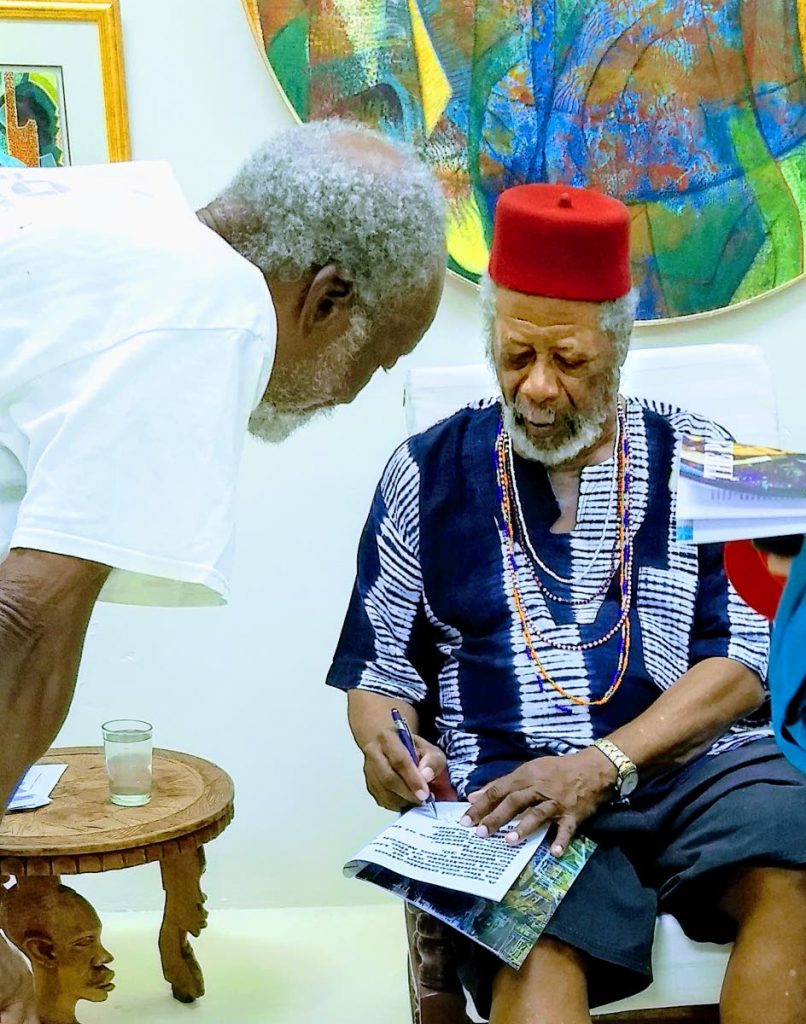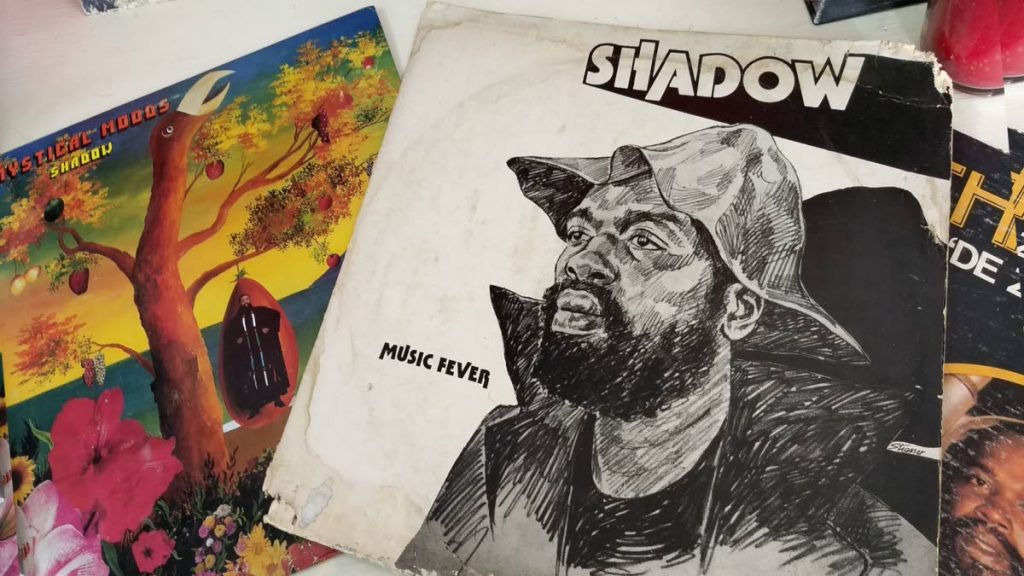The art of obeah

SHEREEN ALI
“Ase, Ase, Ase” rang through the air at the opening prayers of Convois 2019, a two-week tribute to artists Winston “Shadow” Bailey and Leroy Clarke hosted by the Lloyd Best Institute of the Caribbean in Tunapuna.
The Convois this year celebrates the art of Shadow and Clarke who both used ideas of obeah to spiritually inspire and shape their art. The opening night took place on March 19 under a white tent in the backyard of the institute’s offices. The institute is an independent non-profit organisation dedicated to realising the potential of the Caribbean.
The term “Ase” is a West African concept through which the Yoruba of Nigeria conceive the power to make things happen and produce change. It’s a power for change and action that this year’s Convois hopes to foster, starting from within the self. In celebrating obeah as an inspiration in the paintings of Clarke and the calypsoes of Shadow, the institute is reminding people of the power of our own indigenous belief systems as a basis for self-confidence, pride, healing and creative efforts.
An Egungun masquerade invoked the presence of the ancestors at the launch event which was timed to honour the passing of Lloyd Best 12 years ago on March 19, 2007 at 73. Layers of purple, orange, silver and crimson cloth strips masked the Egungun presence which drifted through the gathering, visiting different people and shaking and twirling gently to the sounds of drumming and song. Flambeaux made from dark brown rum bottles lit the entrance to the tent.
Rawle Gibbons, in his opening remarks, spoke of the symbolism of “obi” (kola nut) as the seed through which believers can create the consciousness that connects us to time, to the world environment and to one's own sense of purpose in life.
“Convois is a term from our history, from the underworld organisations created by our enslaved ancestors to do the same things that obeah does, to connect us with our past; but more than that, to strategise and to create actions out of our coming together. And if that is what obeah is, then our problem is not obeah, it is the absence of obeah. Because we still need to strategise and to make things happen,” said Gibbons.

The institute’s first Convois in 2012 developed ideas for future activities. The second, in 2017, led to the birth of the Caribbean Yard Campus and to a series of annual short courses in areas of folk knowledge such as backyard gardening, patois, mas design and indigenous herbal approaches to health. This year’s third Convois celebrates three cultural elders, Clarke, Shadow and Makemba Kunle, and includes an art exhibition (March 19-30), a group mural project, a lecture and a panel discussion on Shadow as a philosopher.
The new institute director, Carmel Best, said for her family, March 19 is always a bittersweet time because it reminds them of the date of their father’s passing. However, she celebrated the institute as an organisation that seeks to understand, learn and teach about Trinidadian and Caribbean society. That is part of Best’s legacy: providing a space for indigenous expression and thought.

Leroy Clarke & Shadow at the Lloyd Best Institute of the Caribbean, 91c
Tunapuna Road, Tunapuna. Exhibit runs until Saturday.
“Both Leroy Clarke and Shadow ask of us very critical questions. Leroy’s question has been: ‘How do we re-chart the ruins?’ And one of Shadow’s many questions has been: ‘What’s wrong with me?’” said Gibbons as he introduced calypsonian Roderick “Chuck” Gordon.
Chuck sang some of Shadow’s thoughtful songs, starting with What Is Life? (1974, from the album Bass Man) which questions the meaning of a life in which things are constantly eating each other up in an eternal struggle:
When a worm in a valley feeding on germs
Up came a fowl who eat up de worm
And den a manicou et de fowl
And den a hunter caught de manicou on the prowl
When he shot the animal and he made a cook
Next week he end up dead like a mook
And when he end up in de cemetery
Same worms end up eating he.
What is Li-i-i-i-fe?
Chuck next sang a song which he thought represented Shadow’s awakening sense of “personal obeah” or realisation of self: One Life To Live (1982, from the album Return of the Shadow). Next came Shadow’s Doh Mess Wid Mih Head (from the 1979 album by the same name), followed by the 1979 Toe Jam, with the quirky lines:
They tell me doh walk with Jacob because Jacob does walk and shake up/They tell me don’t talk to Bertram because the man foot stink with toe jam/They telling me what to do/And they telling me where to go/But the knowledge I want to get/Is how to escape Mr Death.

Feature speaker for the night was Fazal Ali, who is a painter and academic as well as the driving force behind UWI’s Institute of Critical Thinking and the author of a 2017 monograph on Education for Liberty: The future is open to suggestions (available on Amazon/Kindle).
“At the heart of Clarke and Shadow is a black knot of troubling questions about development and douendom,” said Ali.
He spoke of the development economics of Shadow and the visual poetics of Clarke. He examined how art becomes part of the liturgy of African faith as it records the life of humans each day and rejects Dante’s theology and its depictions in European art.
“The glorification of the Middle Passage by Turner in his Slave Ship (painting) is NOT the experience of our ancestors on overcrowded barracoons from India or Africa,” said Ali. Instead, he noted: “Like nail-holes of stars under a rusty galvanised roof, LeRoy Clarke and the Mighty Shadow are delineating a new passage. They are different drummers. They force us to ask: Where is our point of no beginning? The bonded indentureship, the slave ships, tamboo bamboo, Kambule rituals, enslaved Amerindians and embattled Europeans…this is our disaster. And we are yet to settle our joint enslavement and liberation. This is our common ground. Our failure to address these issues has barricaded the distinct groups that make up our society from evolving beyond the initial themes that have preoccupied us since we first arrived.”
In a provocative and wide-ranging philosophical talk, Ali spoke on ideas including the impacts of violation and the need for all TT groups to break free from the contradictions of history and contemporary life to recognise the humanity in all fellow peoples living here.
Ali said Shadow’s insightful sorcery “helps to conjure and foretell the fake oil enigma and even the fate of Petrotrin. He quoted:
"
Big snakes in de country man/Dey wuss than mapipire/When dey making dey racket/Dey does dress up in nice jacket/Some big fat macajuel/drain out de oil in de oil well/I don’t know how dey found de key/But I hear dey empty de Treasury/Snake in de Balisier/ Snake in de Balisier/Snake in de Balisier/And dey biting hard.’ ” (from 1984 album Return of de Bassman)."
Looking at Shadow’s song Poverty Is Hell, Ali spoke of the connection between shame and poverty, and the way poverty can cripple a person’s self-esteem and will to achieve anything. He said Shadow “contests the perception that there is a widespread culture of ‘worklessness’ and dependency as a consequence of the benefits system. Shadow has provided a basis for all national anti-poverty policies that is based on promoting human dignity.”

Ali went on to say poverty “is a deprivation of capability” and spoke of the connection between access to education and distributed justice. But he noted that ambitious educational reform could never end social inequality, because varying levels of education only partially account for wage inequality. Other factors like social origin, the quality of schools and classmates, and the neighbourhood social environment all heavily influence students’ chance of scholastic success.
Ali switched his gaze to Clarke, saying: “Clarke’s continuing project of canvases around the idea of Laventille made him see that Laventille is here, Laventille is there, Laventille is everywhere: violence, fear, poverty, hell and underachievement have no geography.”
Ali spoke of Clarke’s concern with “the knotted question about permanence and impermanence, survival and death, being here and being extinguished. The black hole at the still centre of the LARGE knot of class questions is the dread and fear of absolute impermanence, hence absolute loss of identity, absolute extinguishment of self, into unconscious inexpressiveness.”
“Frederick Nietzsche pronounced the death of God murdered by the believers in an act of regicide. But LeRoy pronounced the death of the madonnas, nativities, stations of the cross and the crucifixion,” said Ali, making the point that the art of Clarke rejects the Christian myths of empire-building and instead embraces African traditional belief systems.
Interestingly, while European Christian belief systems contain ideas of original sin and evil, African belief systems contain the pervasive idea of original blessings, Ali said. It’s a very different way to look at life and the world.
“LeRoy is not working in the frame of Delacroix, Gustave Doré or William Blake, not at all,” said Ali. “The theology of African slaves incorporates the vivid memories and stories of persons ripped out of homelands, separated from kith and kin, and trafficked out on a shameful sea journey fatal to many in the human cargo. This is what Clarke’s slave ship portrays: the cadaver, and the suffering above and below the slave ship. It openly opposes Turner’s glorification in gold. Hell is here on earth, in the blistering heat of the cane fields, the hunger of the jobless that make poverty a hell, the daily mortality from disease, malnutrition and the disaster of hurricanes and floods.
“Dantesque versions litter the poetry and paintings of Christians today: eternal fires meet the unrepentant who committed the seven deadly sins, limbo and purgatory were the stations where the innocent children and the repentant deceased await a second coming and judgment.
In contrast to these ideas, he said, "The work of LeRoy Clarke and Winston Bailey sustain the practice of African faiths and belief systems that depict earthly conduct and create new stories that could be added to the liturgy. The liturgy is not fixed and is open to additions constantly. The central figure of this way of being is a code of health and healing for social and human diseases.
“These two drummers place their heart at the head of the living dead, and the battery of drums throb, hoping for us to open our eyes. They remind us of our original blessings, the stains of corruption and the hell of poverty, human dignity and the challenges of douendom and development.”


Comments
"The art of obeah"